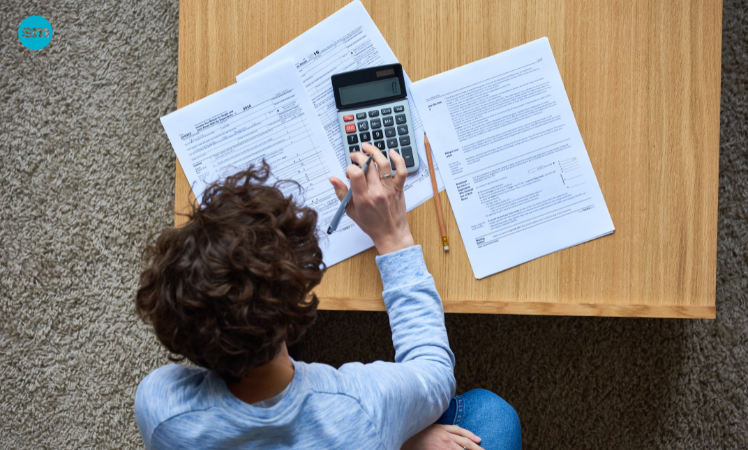Last Updated on September 15, 2023 by Lori Pace
Margaret Mitchell, once wrote, “Death, taxes, and childbirth! There’s never any convenient time for any of them.” Sadly, this is still true even today. Just the mere thought of doing your tax return can make any single mother want to pull their hair out.
Today, filing your tax return doesn’t have to be an entirely painful process. With my years of experience navigating the tax system as a single mother, I can attest that the internet has opened up opportunities to learn the ins and outs of tax returns more easily than ever before. Knowing more about the process will make it a lot easier and a lot less stressful.
Single Mother Tax Return: What Is It?
A tax return just consists of forms that you need to file with the Internal Revenue Service (IRS). These forms will show what you earned in the year and what your expenses were. Your tax return will also include other important information.
A tax return can be handy because you can use it to work out how much you must pay in taxes, make a tax payment plan, or even get a tax refund for when you’ve paid too much. You need to file a tax return once a year for yourself and for your business if you have one.
How Much Do You Need To Earn To Pay Taxes?
You might also be wondering how much you need to earn to pay your taxes. This can change depending on your filing status.
When you’re filing as a single person, and you’re younger than 65 years old, you need to make a minimum of $12200 in a year. If you’re older than 65 years old, the minimum income becomes $13850 per year.
If your spouse passed away during the tax year, and you’ve listed your child as your dependent, you would qualify as a widow. This can affect the minimum income you need for filing your tax return. If you’re younger than 65 years old, your minimum income needs to be at least $24400, and $25700 if you’re older than 65.
To qualify as a “Head of Household,” you will still need to file a tax return. You will need to earn a minimum of $18350 if you’re younger than 65 years old. For a single mom, that’s older than 65 years, you need a minimum gross income of $20000.
Filing Your Single Mother Tax Return Step-By-Step
For many single mothers, filing your tax return can seem like a complicated process. You might not even know where to begin or even when you’re supposed to file your tax return. Luckily, there are helpful sites with all this information to help you out.
Filing a tax return can be a unique process for each individual, depending on their circumstances. For instance, as a self-employed single mother, I’ve faced distinct challenges. Let’s explore the different scenarios, from employment to self-employment, to provide you with a comprehensive guide. In almost all cases, there is a basic step-by-step process that you can follow.
Step One: Paperwork
Before anything else, you need to get your paperwork together. Your paperwork should include a W-2 form from your employer. If you have more than one job, you need a W-2 form from each employer. You should also include your 1099 and 1099-INT forms to show the other ways you’ve earned money.
Step Two: Filing status
When you fill out your tax return, you need to choose the filing status that applies to you. Your status depends on whether you’re married or not. It also depends on how much you spend on your household expenses. All these factors can affect your filing status on your tax return.
Just be sure to file your taxes on time. Filing late could lead to a penalty of 5% of your owed tax for each month that you’re late. If it’s more than 60 days late, there is a minimum penalty of $435 or the amount owed on your tax. It will depend on which amount is smaller.
Step Three: How To File Your Tax Return
After you’ve gotten your paperwork and filing status sorted out, you need to decide how you’ll file your tax return. There are three ways that you can use to file your taxes.
The first option is filing your taxes manually. You can do this by filling in Form 1040 and mailing it to the IRS. You should also include any payment that you might owe. This is a great option because it’s free.
With the second option, you can use a software program or website (usually for a fee) to help you file your taxes. In most cases, you’ll have to answer questions about any deductions you might have had and the money you’ve earned. Thereafter, it will fill out your 1040 based on the answers you gave.
Lastly, you can hire a tax professional or an accountant to help you file your tax return. They will work to help you get the most out of your tax return. While it’s handy to have a professional to help you, it could end up costing you a lot of money.
Step Four: Standard Or Itemized Deduction
The next thing that you need to decide is if you’re going to use standard or itemized deductions with your tax return. There are pros and cons to both methods.
If you use the standard deduction method, you need to remember that the deduction amount can change. The deductions will differ depending on your earnings, how old you are if you’re blind, and your filing status. This sort of deduction can change every year.
Just keep in mind, that in some cases you won’t be able to use a standard deduction in your tax return. You won’t be able to use this deduction if you’re filing a return for a period of fewer than 12 months because of any change during the tax year. You also won’t be able to use this deduction if you’re a non-resident alien or if you have dual status during the tax year.
The next option for taxpayers is to use itemized deductions in their single-mother tax return. There are two reasons to use this deduction. You can use it when you can’t use the standard deduction or when you’re allowed itemized deductions less.
Your itemized deductions could include the amount of money you paid to local and state income or sales taxes, property taxes, and interest on your mortgage. With this deduction, you can include any donations and gifts you’ve given to charity. You can also include some of the money you used to pay medical and dental bills.
Step Five: Pay Your Taxes
After you’ve filed your tax return, there’s a chance that you could owe some money. Then you need to decide how you’re going to pay your taxes. There are different options for you to choose from.
The first two options would be to pay your taxes with your debit or credit card or with a bank transfer. If you decide to use e-filing, you can use the Electronic Funds Withdrawal method. You can also pay using the Electronic Federal Tax Payment System, same-day wire, check, or money order or you could even use the old-fashioned method of paying with cash.
What if you’re in a situation where you can’t pay your taxes all at once? Luckily, you can create a payment plan to help you pay off your taxes. These payment plans will often let you pay what you owe in installments.
Another option is to see if you qualify for an “offer in compromise.” With this option, you will only have to pay a small amount of what you owe on your taxes. You could qualify for this option if you can’t pay what you owe or if you’ll be put in a difficult position by paying the full amount.
Another option for you is to request a “temporary delay collection“. This will give you some extra time to pay your taxes, and you’ll only have to pay when your finances improve. To request this, you will have to complete a “Collection Information Statement” and prove that you’re struggling financially.
How To Get An Extension On Filing Your Single Mother Tax Return
In some cases, you might need more time to prepare your tax return. In this situation, you can apply for an extension on filing your tax return. Just keep in mind, that this extension doesn’t apply to paying your taxes, just filing your tax return.
Calculating Your Taxes
For single mothers with a steady job, your taxes will be calculated after you’ve filled out a Form W-2 that you’ll get from your employer. This form will show how much you were paid and how much of your wages contributed towards your taxes. This information then goes on your tax return to work out how much you owe in taxes or how much of a refund you’ll get.
If you’re a single mother who is self-employed or works as an independent contractor, your tax situation is unique. In my own experience, I’ve received 1099 forms from my bank or investment firm, detailing my income and interest earnings. Just keep in mind that you’ll be responsible for making sure that you pay off your taxes during the year.
Understanding Tax Brackets
You’ve likely come across the term ‘tax bracket,’ but understanding its nuances can be challenging. Based on my own journey through the tax system, I’ll provide you with a detailed explanation of tax brackets and how they impact your financial situation. You might not even be certain what tax bracket you belong in. Understanding what tax brackets are and how they work is another essential part of filing your tax return.
A ‘tax bracket’ is a fundamental concept that determines your tax liability based on your income. Drawing from my own experiences, I’ll explain how these brackets work and what they mean for your finances. So, if you’re a single mother with a low income, you’ll be in the lowest bracket which is 10% of the first $9950 for 2021. This means that if you earned $9950 during the tax year, 10% of what you earned needs to be paid in taxes to the IRS.
If your filing status is ‘head of household’ for your tax return, and you earned $14,200 during the tax year, your tax bracket will indeed be 10%. This means you’d owe $1,420 in taxes. I’ve seen firsthand how these brackets work, and it’s important to understand how they apply to your specific situation.
This system helps to make sure that taxpayers in the same tax bracket pay the same rates. This also means that the more money you earn, the more you’ll pay in taxes. Simply put, your tax bracket will determine how much you pay in taxes.
Using Tax Deductions
Tax deductions can be used to reduce how much you’ll owe in taxes by decreasing your taxable income. An example of a tax deduction is making a gift or donation of up to $300 to a charity or nonprofit organization. This will just lower your income, which will reduce how much you will pay in taxes.
It’s important to note that not all your expenses during the tax year can be used as tax deductions. I’ll provide insights into which expenses can and cannot be deducted, drawing from my firsthand knowledge as a single mother who has navigated these complexities. Things such as medical expenses can be limited to a certain percentage of your adjusted gross income (AGI). You should also decide if you’re going to use standardized or itemized deductions in your tax return.
Saving Money With Tax Credits
Tax credits operate differently compared to tax deductions. From my firsthand experience, tax credits directly reduce the amount you owe in taxes to both federal and state governments, making them a valuable tool in managing your tax liabilities. These credits can be used to pay for any expenses you’ve had during the year.
Tax credits work as a dollar-for-dollar reduction in the income tax you owe. So, for example, if you owe $500 in taxes, but you’ve got a $500 tax credit, your debt will be canceled out.
There are even refundable tax credits where you can either get the full amount or a portion of the amount, even if you owe money to the IRS. This means that if your tax is $500, and you’ve got $1000 in credit, then you’ll get a $500 refund.
How To Get Your Single Mother Tax Return
When you’ve completed your tax return, you might find out that you’re owed some money. But how do you get your refund? Well, there are some options that you can use to do this.
You could get a check in the mail. If you prefer, your refund could be directly deposited into your bank account. With a direct deposit, you can choose to split your refund into different accounts.
The IRS website offers a reliable tool called ‘Where’s my refund?’ for tracking your refund status. Based on my personal experience, if you used e-filing, you can begin checking your refund status within the first 24 hours. However, if you opted for manual filing, you may need to wait approximately four weeks before tracking your refund.
Where To Get Help With Your Single Mother Tax Return?
I understand how overwhelming the thought of doing your taxes can be, especially for single mothers. While this guide aims to simplify the process, it’s crucial to recognize when seeking professional advice may be in your best financial interest. For anyone who is struggling to do their taxes, there are different sites and programs that help single moms in this situation.
Volunteer Income Tax Assistant (VITA)
The Volunteer Income Tax Assistant (VITA) is a program that’s offered by the IRS. The program offers free tax assistance to people who earn less than $54000 per year, the elderly, people who struggle with the English language, and people with disabilities.
Low-Income Tax Clinic (LITC)
There might be a time when you will have a dispute with the IRS. This is when you’ll need help from the Low-Income Tax Clinic (LITC). This is another program that is funded by the IRS to assist people with a low income.
Luckily, you don’t have to go through any application process to use this program. For a small fee, the LITC will assist you with audits, federal tax litigation, and any collection matters.
An Interactive Tax Assistant
The next time you need help with your tax return, you should check the IRS website for their handy Interactive Tax Assistant (ITA). The ITA can give you answers to questions about your tax return. You can ask questions about when to file your taxes, what forms you should complete, and so on.
You can also anonymously submit your information to find out more about your taxes. Not only that but your information won’t be stored once you’ve left a topic. That way, your information won’t be stored for a third party to find.
Last Word On Filing Your Single Mother Tax Return
The government funds numerous programs and organizations aimed at assisting individuals with their tax returns. I’ve personally benefited from some of these resources and can guide you on where to find reliable government-backed assistance. Along with these, the IRS has all the information on its website. These programs can even help you deal with any disputes you might have and even an audit.
All these programs, along with my extensive experience as a single mother dealing with taxes, are easily accessible with just a click. I understand the challenges single mothers face when it comes to taxes, and I’m here to help you navigate the resources and information you need to file your tax return confidently. Having all this information will be sure to make filing your next tax return painless and stress-free.



